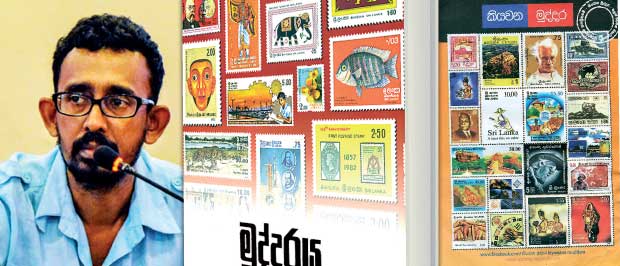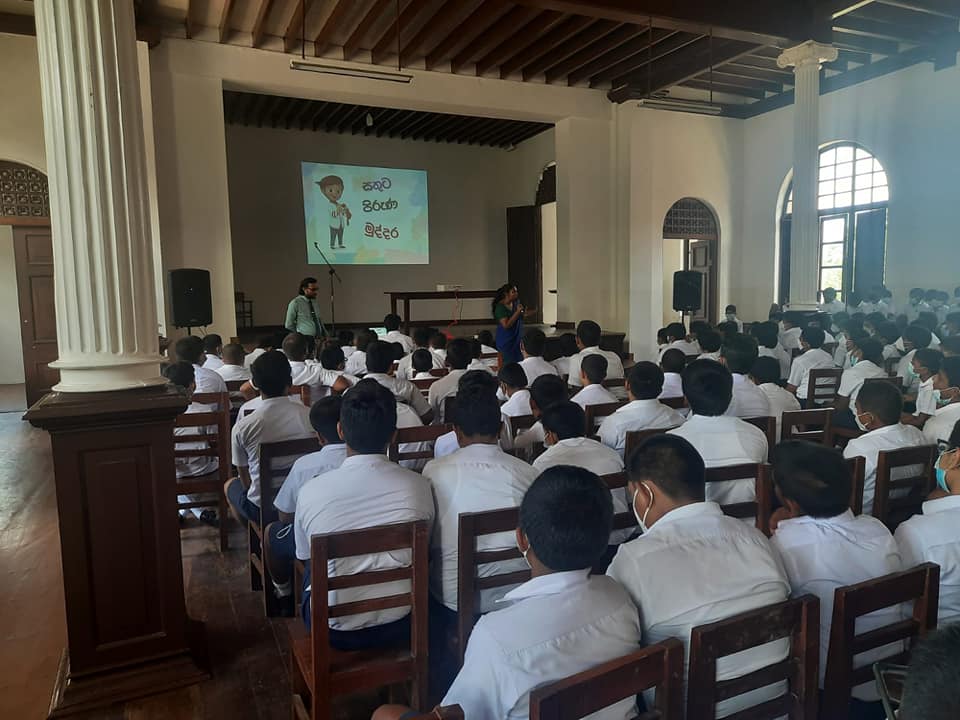by Gamini Akmeemana
Niroshana Pieris is no ordinary stamp collector. In fact, he doesn’t describe himself as one at all. He’s a philatelist with a consummate interest in the history of stamps who attributes his youthful looks to his passion for pieces of paper with pictures on one side and gum on the back.
His book ‘Muddaraya Eda Ada Saha Heta’ (The Stamp Then, Now and in Future) is easily the best book of its kind, written by a Sri Lankan author, that I have seen so far.
His first book, ‘Sri Lanka Muddara Ithihasaya’ published in 2007 is probably the first comprehensive book on the literature of stamp to come out in Sinhala. This was followed in 2008 by ‘Parisara Wisithuru Mathu Kala Muddara.’
This isn’t just about stamp collecting. This book is written with a sweep which covers the history of philately from the inception, in Sri Lanka and worldwide, from Britain’s Penny Black to Sri Lanka’s first stamp carrying Queen Victoria’s image
This third publication, now approved for school libraries by the Ministry of Education, is loaded with detail, but designed in a very readable manner. This isn’t just about stamp collecting. This book is written with a sweep which covers the history of philately from the inception, in Sri Lanka and worldwide, from Britain’s Penny Black to Sri Lanka’s first stamp carrying Queen Victoria’s image and valued at six pence. A detailed description of this early postal history of the island and this stamp are given.
Running concurrently is postal history, from Rowland Hill’s revolution in postal systems to how the hobby of stamp collecting started worldwide. Members of the British Royal family, among the world’s pioneer stamp collectors, are featured. Sri Lanka’s postal history, from introducing Asia’s first mail coach service to building the first post offices and the General Post Office (GPO) in Fort are detailed. Even the cost of constructing the GPO is given. Among Sri Lanka’s pioneer collectors was Sir Ernest de Silva. The funds to build the Colombo YMBA building came from the sale of a single stamp from Mauritius in his collection.
A brief bio
Niroshana studied at Ananda Shastralaya, Kotte and followed it up with a diploma in mass communications from the University of Sri Jayawardhanapura. He has worked as a researcher for Sri Lanka Environmental Journalists’ Association and now works for the Campaign for Free and Fair Elections (CAFFE).
While at the SLEJA, Niroshana covered a lot of ground for that institution’s comprehensive book on Sri Lanka’s waterfalls, and remarks that the poet Meemana Premathilake and novelist Martin Wickremasinghe could be considered as pioneers of waterfall literature in Sri Lanka.
He first came across Sri Lankan stamps depicting waterfalls while working on that project. There are two sets of stamps with waterfalls as the theme. Realising the educational potential in stamps, he set out to uncover the story behind each stamp. It’s an ideal calling for ‘a self-employed archivist passionate about history,’ as Niroshana calls himself.
His life as a philatelist journalist started in 2007, when he wrote an article for the Lankadeepa newspaper on the 150th anniversary of Sri Lanka’s postage stamps. The history of Sri Lanka’s philatelic journalism is sketchy at best. Though the country’s philatelic activity is said to have experienced its golden age in the 1960s (like in many other things), the only notable philatelic journalist who comes to mind is the late Francis P. Gunasekara, and there has been no successor till Niroshana threw himself into this neglected subject.
His life as a philatelist journalist started in 2007, when he wrote an article for the Lankadeepa newspaper on the 150th anniversary of Sri Lanka’s postage stamps
Society of philatelists
Sri Lankan stamp collecting represents a two-tiered pyramid. The base consists of a large number of hobby collectors, ranging from schoolchildren to adults, who collect without really being aware that philately is actually a science. At the top, one finds a small group of knowledgeable collectors. Unfortunately, they make it sound more like a business investment than a hobby. Some are known to keep collections in air-conditioned rooms and rarely show them to anyone. There is a society of philatelists, but public displays are rarely announced. The Philatelic Bureau too, organises exhibitions periodically, but these are lackluster affairs and Sri Lanka is very much out of the international philatelic mainstream.
Niroshana’s vision is not to have just tens of thousands of stamp collectors or small groups with business interests. He would like to introduce a cerebral approach to the hobby, getting enthusiasts involved with ethnological and cultural angles as well as history and geography. His reading of stamps under the theme of Sigiriya is a good example of this approach.
Grouped together under this theme are twenty stamps. At first glance, only twelve of them seem to be directly related to the theme, depicting the rock fortress, its famous frescoes, and architectural highlights such as the lion’s paw staircase. But a careful reading of this theme would show that the remaining eight portray personalities and organizations connected to the theme – from British era archaeologist H. C. P. Bell who discovered the ruins, to archaeological commissioner Dr. Senarath Paranavithana who did so much to interpret its art and graffiti, to World Tourism Day and the 15th gathering of SAARC leaders, all these stamps are related to the theme if one knows the story behind them.
He first came across Sri Lankan stamps depicting waterfalls while working on that project. There are two sets of stamps with waterfalls as the theme. Realising the educational potential in stamps, he set out to uncover the story behind each stamp
Niroshana is a frequent visitor to the Sri Lanka Philatelic Bureau to discuss philatelic matters in an unofficial capacity. His dedication to the subject is amazing and hopefully he will achieve his dream of getting enthusiasts not just to buy stamps, but to read and unravel them.
Source: Daily Mirror 18th January 2018
![]()




